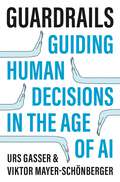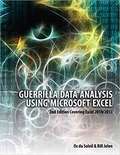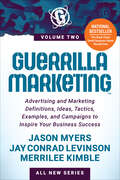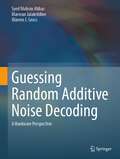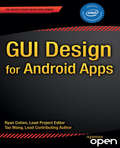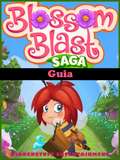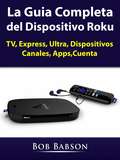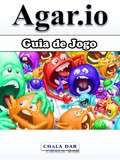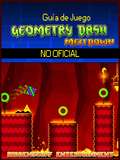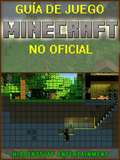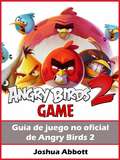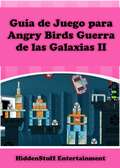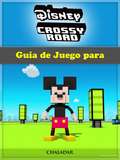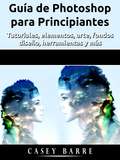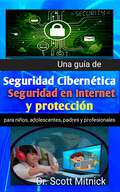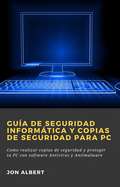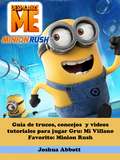- Table View
- List View
GT Racing 2 Guía No Oficial
by I. Fernández Joshua AbbottGUÍA NO OFICIAL Además de comprar el libro puedes registrarte para entrar en nuestro programa de suplementos para las guías. Pinchando en el link que te mostramos a continuación puedes acceder a las últimas actualizaciones sobre las apps y videojuegos más populares. Regístrate gratis aquí: http://emailsignupform.subscribemenow.com/ Guía con consejos avanzados y estrategia. Es la guía más completa y detallada que encontrarás en la red. Disponible en descarga instantánea en tu teléfono móvil, dispositivo para ebooks o en papel. Tras el éxito de mis cientos de guías y estrategias, he vuelto a escribir otra guía profesional y avanzada para jugadores nuevos y veteranos. Encontrarás estrategias específicas y consejos sobre cómo ir avanzando en el juego, vencer a tus adversarios conseguir más dinero y mucho más. Esto es lo que obtendrás al comprar esta guía profesional, avanzada y detallada. *Consejos y estrategias profesionales. *Trucos *Secretos, consejos y trucos que utilizan los jugadores pro. *Cómo conseguir muchísimas monedas. *¡Y mucho más! Todas las versiones de esta guía tienen capturas de pantalla para ayudarte a entender mejor el juego. No hay otra guía que sea tan completa y avanzada como esta. Te alegrarás de haber comprado esta guía y te beneficiarás excepcionalmente en comparación con otras guías menos eficientes que hay en el mercado. ¡Cómprala ya y destroza a tus adversarios! ¡Conviértete en un jugador pro hoy mismo! Si necesitas ayuda o más información sobre nuestros productos visita www.hiddenstuffentertainment.com/ Descargo de responsabilidad Este producto no está asociado, afiliado, promocionado, certificado o financiado por el propietario original del copyright. Todas las marcas y marcas registradas que aparecen en este libro son propied
Guardrails: Guiding Human Decisions in the Age of AI
by Urs Gasser Viktor Mayer-SchönbergerHow society can shape individual actions in times of uncertaintyWhen we make decisions, our thinking is informed by societal norms, &“guardrails&” that guide our decisions, like the laws and rules that govern us. But what are good guardrails in today&’s world of overwhelming information flows and increasingly powerful technologies, such as artificial intelligence? Based on the latest insights from the cognitive sciences, economics, and public policy, Guardrails offers a novel approach to shaping decisions by embracing human agency in its social context.In this visionary book, Urs Gasser and Viktor Mayer-Schönberger show how the quick embrace of technological solutions can lead to results we don&’t always want, and they explain how society itself can provide guardrails more suited to the digital age, ones that empower individual choice while accounting for the social good, encourage flexibility in the face of changing circumstances, and ultimately help us to make better decisions as we tackle the most daunting problems of our times, such as global injustice and climate change.Whether we change jobs, buy a house, or quit smoking, thousands of decisions large and small shape our daily lives. Decisions drive our economies, seal the fate of democracies, create war or peace, and affect the well-being of our planet. Guardrails challenges the notion that technology should step in where our own decision making fails, laying out a surprisingly human-centered set of principles that can create new spaces for better decisions and a more equitable and prosperous society.
Gudetama Cross-Stitch: 30 Easy-to-Follow Patterns from Your Favorite Lazy Egg
by Sosae Caetano Dennis CaetanoGudetama Cross-Stitch combines cross-stitching fun with 30 easy-to-follow patterns inspired by everyone's favorite lazy egg with the can't-be-bothered attitude. Gudetama&’s name literally translates to &“lazy egg,&” and it&’s how we all feel sometimes when it comes to, well, pretty much anything. But if you&’re the kind of person who doesn&’t have time for complicated crafts or dealing with other people, then this collection of 30 Gudetama-inspired designs are just for you. First, you&’ll learn cross-stitching basics including tools and techniques and how to read a cross-stitch chart. Then you&’ll apply your new skills to a range of hilarious and lovable patterns organized into chapters like Lazy, Medium-Lazy, and Pay Attention—depending on how sluggish or motivated you&’re feeling. Finally, you&’ll be able to apply your masterpieces to projects like gift tags, greeting cards, and ornaments. Whether you&’re an experienced cross-stitcher or new to the craft, you&’ll find a variety of poses and patterns in this book that are accessible and easy to learn. With a little patience and practice, anyone can bring these Gudetama-inspired masterpieces to life. And if not, just take a nap.
Guerilla Data Analysis Using Microsoft Excel
by Oz Du Soleil Bill JelenThis book includes step-by-step examples and case studies that teach users the many power tricks for analyzing data in Excel. These tips have been honed by Oz du Soleil, a former financial analyst charged with taking mainframe data and turning it into useful information quickly, and “Mr. Excel” himself, Bill Jelen. Topics include data quality, validation, perfectly sorting with one click, matching lists of data, data consolidation, data subtotals, pivot tables, pivot charts, tables, and much more. This new edition has been updated for Excel 2013.
Guerrilla Marketing: Advertising and Marketing Definitions, Ideas, Tactics, Examples, and Campaigns to Inspire Your Business Success
by Jason Myers Jay Conrad Levinson Merrilee KimbleFocused on low-cost, strategic marketing concepts that will creatively promote a compelling product or service, Guerrilla Marketing’s winning approach relies on knowledge, time, energy, and imagination rather than a big marketing budget. Now, the winning continues with Guerrilla Marketing Volume 2.
Guessing Random Additive Noise Decoding: A Hardware Perspective
by Syed Mohsin Abbas Marwan Jalaleddine Warren J. GrossThis book gives a detailed overview of a universal Maximum Likelihood (ML) decoding technique, known as Guessing Random Additive Noise Decoding (GRAND), has been introduced for short-length and high-rate linear block codes. The interest in short channel codes and the corresponding ML decoding algorithms has recently been reignited in both industry and academia due to emergence of applications with strict reliability and ultra-low latency requirements . A few of these applications include Machine-to-Machine (M2M) communication, augmented and virtual Reality, Intelligent Transportation Systems (ITS), the Internet of Things (IoTs), and Ultra-Reliable and Low Latency Communications (URLLC), which is an important use case for the 5G-NR standard. GRAND features both soft-input and hard-input variants. Moreover, there are traditional GRAND variants that can be used with any communication channel, and specialized GRAND variants that are developed for a specific communication channel. This book presents a detailed overview of these GRAND variants and their hardware architectures. The book is structured into four parts. Part 1 introduces linear block codes and the GRAND algorithm. Part 2 discusses the hardware architecture for traditional GRAND variants that can be applied to any underlying communication channel. Part 3 describes the hardware architectures for specialized GRAND variants developed for specific communication channels. Lastly, Part 4 provides an overview of recently proposed GRAND variants and their unique applications.This book is ideal for researchers or engineers looking to implement high-throughput and energy-efficient hardware for GRAND, as well as seasoned academics and graduate students interested in the topic of VLSI hardware architectures. Additionally, it can serve as reading material in graduate courses covering modern error correcting codes and Maximum Likelihood decoding for short codes.
GUI Design for Android Apps
by Ryan Cohen Tao WangGUI Design for Android Apps is the perfect and concise introduction for mobile app developers and designers. Through easy-to-follow tutorials, code samples, and case studies, the book shows the must-know principles for user-interface design for Android apps running on the Intel platform, including smartphones, tablets and embedded devices. This book is jointly developed for individual learning by Intel Software College and China Shanghai JiaoTong University, and is excerpted from Android Application Development for the Intel(r) Platform. What you'll learnKey aspects of why UI and UX design for embedded systems is different than for desktopsTroubleshooting UI design issuesUnderstanding how key concepts such as state transition, context class, and intent workHow to use the interface app design tools provided by AndroidPlanning for complex apps (apps with multiple activities)Optimizing app design for touch screen inputWho this book is for The book is primarily for app developers, software engineers and open-source programming enthusiasts, but can also be used by for training programs and Codeacademy-style programs. Table of ContentsForeword/PrefaceChapter 1. General OverviewChapter 2. The Android-Specific GUIChapter 3. Designing Complex ApplicationsChapter 4. Self-Drawing Graphics and Touch Screen InputConclusion"
Guia Blossom Blast Saga
by Hiddenstuff Entertainment Leonardo MagalhãesGuia de Dicas e Estratégia Avançada. Este é o guia mais abrangente e detalhado da internet. Disponível para download imediato em seu celular, dispositivo de eBook, ou brochura. Com o sucesso das centenas de guias e estratégias, escrevi outro guia profissional avançado para jogadores novos e veteranos. Este oferece estratégias e dicas específicas sobre como progredir no jogo, derrotar seus oponentes, adquirir mais moedas, e muito mais! Eis o que você terá ao comprar este guia profissional detalhado e avançado. - Dicas e Estratégias Profissionais. - Truques e Macetes. - Segredos, Dicas, Macetes e Truques usados por jogadores experientes! - Como conseguir várias moedas. - E MUITO MAIS! Todas as versões deste guia possuem imagens de tela para lhe ajudar a entender melhor o jogo. Nenhum outro guia é tão abrangente e avançado como este. Você irá gostar de ter comprado este guia, e terá muitos benefícios em comparação a outros guias menos eficazes por aí. Compre agora e destrua seus oponentes! Torne-se um Jogador Experiente Hoje! Para suporte e mais informações sobre nossos produtos, visite: http://www.hiddenstuffentertainment.com/.
La Guia Completa del Dispositivo Roku: TV, Express, Ultra, Dispositivos, Canales, Apps,Cuenta
by Bob BabsonGuia para Usuarios Roku. Esta guia le mostrará algunos consejos para usar su dispositivo Roku ademas de todos los beneficios con los que cuenta al haberlo adquirido.
Guía de desintoxicación digital: Cómo vencer la adicción a las redes sociales
by Gary RandolphAunque las redes sociales son una gran herramienta para comunicarse con los amigos y la familia, y para adquirir conocimientos e información, su uso sin límites no es bueno para la salud mental. Hoy en día las personas se han vuelto adictas a las redes sociales y también la actividad física que realizan ha disminuido. Si te has vuelto adicto a las redes sociales y quieres cambiar tus hábitos cotidianos, esta guía es para ti. Esta guía electrónica describe el proceso completo de Desintoxicación Digital. Si quieres vencer la adicción a las redes sociales, esta guía es para ti. En esta guía aprenderás: - Las diez mejores maneras de deshacerse de la adicción a las redes sociales - Cuentas que debes eliminar - Hacer un uso mínimo de las cuentas - Cómo limitar tu lista de amigos - Uso mínimo del dispositivo - Reorganizar tus prioridades - Tener tiempo libre para tus relaciones reales - Pasos a seguir - ¡Y mucho más! --> Desplácese hasta la parte superior de la página y seleccione "Añadir al carrito" para comprar inmediatamente Aviso de responsabilidad: Este autor y/o el/los propietario/s de los derechos de autor no aseguran, ni prometen, ni garantizan la exactitud, integridad o adecuación del contenido de este libro, y no se hacen responsables de los errores u omisiones en su contenido. Este producto es sólo para uso de referencia. Por favor, consulte a un profesional antes de aplicar cualquier medida sobre los temas incluidos en este libro.
Guía de Escritores para Usar el Software de Reconocimiento de Voz
by Barbara WatkinsonComo escritores, todos sabemos lo que puede ser un increíble software de dictado de herramientas. Nos permite escribir más rápido y evitar los peligros de RSI y un estilo de vida sedentario. Pero muchos de nosotros dejamos de dictar cuando nos damos cuenta de que no podemos obtener la precisión que necesitamos para ser verdaderamente productivos. Este libro cambia todo eso. Con casi dos décadas de uso del software Dragon en su haber y una gran cantidad de conocimiento interno de la industria del dictado, en el libro se revelará cómo sobrecargar su escritura y lograr una precisión de reconocimiento inmejorable desde el momento en que comienza a usar el software.
Guia de Jogo Agar.io
by Hiddenstuff Entertainment Rafael da Silva RamaGuia Não-Oficial do Agar.io por HiddenStuff Entertainment Passa Níveis & Ganha Poderes! *GUIA NÃO-OFICIAL* Para além de comprares este eBook, inscreve-te também no nosso programa suplemento de guia grátis. Ao copiares o link que se encontra em baixo, terás acesso às novidades mais recentes relativas às aplicações e aos videojogos. Inscreve-te gratuitamente em baixo: http://emailsignupform.subscribemenow.com/ Dicas Avançadas & Guia Estratégico. Este é o único guia abrangente e detalhado que encontrarás online. Disponível para download instantâneo no dispositivo eBook do teu telemóvel ou em formato brochura. Com o sucesso das minhas centenas de outros guias e estratégias escritos, escrevi outro guia profissional avançado para jogadores novos e veteranos. Este oferece estratégias e dicas específicas para avançares no jogo, derrotares os teus adversários, adquirires mais moedas e dinheiro, e muito mais! Aqui está o que obterás quando comprares este guia profissional e detalhado - Dicas e Estratégias Profissionais. - Cheats e Hacks. - Segredos, Dicas, Desbloqueadores e Truques Usados Por Jogadores Profissionais! - Como Ganhar Muito Dinheiro/Moedas. - E MUITO MAIS! Todas as versões deste guia têm imagens para te ajudar a entenderes melhor o jogo. Não existe nenhum guia que seja tão abrangente ou avançado como este. Ficarás satisfeito ao comprares este guia e ganharás muito mais com ele do que com outros guias muito menos eficazes. Compra agora e esmaga os teus adversários! Torna-te um Jogador Profissional ainda HOJE! Se precisares de ajuda ou mais informações relativamente aos nossos produtos, visita: http://www.hiddenstuffentertainment.com/ Aviso: Este produto não está associado, afiliado, aprovado, certificado ou financiado pelo Dono Original dos Direitos de Autor. Todas
Guía de Juego Geometry Dash Meltdown no Oficial
by José Luis Patricio González Hiddenstuff EntertainmentAdemás de la compra de este libro electrónico, siéntete libre de registrarte en nuestro programa suplementario de guías gratuitas. Al copiar el link presentado a continuación ganarás acceso a las últimas actualizaciones y noticias de los juegos y aplicaciones online más populares. Regístrate de manera gratuita aquí: http://emailsignupform.subscribemenow.com/ Guía de Consejos Avanzados y Estrategias. La presente es la única y más detallada y completa guía que encontrarás online. Disponible para su descarga instantánea en tu teléfono celular, dispositivo eBook, o en formato físico. Con el éxito de mis cientos de otras guías escritas y estrategias, he escrito otra guía avanzada para tanto jugadores nuevos y veteranos. ¡Esta guía otorga estrategias específicas y consejos sobre cómo avanzar en el juego, vencer a tus oponentes, adquirir más monedas, y mucho más! Lo siguiente es lo que adquirirás con la compra de esta guía profesional avanzada y detallada de juego. - Estrategias y consejos profesionales. - Trucos y hacks. - ¡Secretos, consejos, trampas, desbloqueables, y trucos usados por jugadores profesionales! - Cómo conseguir muchas cantidades de dinero/monedas. - ¡Y MUCHO MÁS! Todas las versiones de esta guía poseen capturas de pantalla para ayudarte a entender de mejor manera el juego. No existe otra guía tan avanzada y completa como ésta. Si estás buscando guías sobre otros juegos y aplicaciones populares siéntete libre de buscar otros títulos por Joshua J Abbott o HSE Games. Estarás contento de haber comprado esta guía, y te beneficiarás de ella enormemente comparado a otras guías menos efectivos que circulan por la web. ¡Cómprala ahora y destruye a tus oponentes! ¡Conviértete en un jugador profesional hoy! Para soporte y mayor información sobre nuestros productos, visita: http://www.hiddenstuffentertainment.
Guía de juego Minecraft no Oficial
by José Luis Patricio González Joshua Abbott¡Con mi Guía Definitiva de Minecraft aprenderás exactamente lo que necesitas saber para convertirte en un jugador experto! La presente es una guía completa con todo lo que necesitas saber sobre el juego y ADEMÁS serás capaz de descargar una copia gratis del juego por la compra de esta guía. - Resume e información básica. - Estrategias avanzadas. - Todo sobre los objetos. - Todo sobre los Mobs. - Todo sobre los Biomas. - Todo sobre los encantamientos. - Todo sobre el crafteo. - Todo sobre los brebajes. - Todo sobre las mazmorras. - Todo sobre los mini juegos. - Todo sobre las granjas. - Cómo encontrar y derrotar al Ender Dragon. - Cómo conseguir objetos infinitos. - ¡Secretos, consejos, desbloqueables, y trucos usados por los jugadores profesionales! - Capturas de pantalla reales. - ¡Y MUCHO MÁS! ¡Cómprala ahora y nunca más tendrás que luchar por sobrevivir! ¡Conviértete en un jugador profesional!
Guía de juego no oficial de Angry Birds 2
by Hiddenstuff Entertainment Rafael J. Torres Gila¡Gana niveles, consigue Power-ups y obtén la mejor puntuación! ¡Con mi guía aprenderás todo lo que necesitas para convertirte en un jugador experto y superar todos los niveles! Esta es una guía completa con información imprescindible acerca del juego. - Consejos y estrategias nivel experto. - Trucos y hacks. - Recompensas diarias. - Tipos de pájaros. - Tipos de niveles. - Hechizos. - Gemas. - ¡Secretos, ayudas, trucos, desbloqueables y tácticas de jugadores profesionales! - Información relevante y estrategias de Wiki. - Estrategias generales de Apps para principiantes. - ¡Y MUCHO MÁS! ¡Consíguela ahora y acaba con tus enemigos! ¡Conviértete en un jugador profesional hoy mismo!
Guía de Juego para Angry Birds Guerra de las Galaxias II
by Hiddenstuff Entertainment Tania CalderonCon mi última Guía de Juego de Angry Birds Star Wars II aprenderás exactamente lo que necesitas saber para convertirte en un jugador experto y obtener los puntajes más altos en cada nivel. Esta es una guía completa con todo lo que necesitas saber del juego Y ADEMÁS podrás bajar el juego gratis con esta compra. *Cómo bajar el juego Angry Birds Star Wars II GRATIS. *Secretos, tips, trampas y trucos usados por los jugadores profesionales. *Accesible para PC, IPhone y Android. *Una vista detallada de todos los pájaros. *Paso a paso de como vencer el nivel, obtener 3 estrellas y conseguir los puntajes más altos. *Vista de los logros. *Vista de todos los Mapas del Tesoro. *Vista de las Cajas de Bonus. *Vívidas capturas de pantalla. *Estrategias generales para el juego. *¡Y MUCHO MÁS! ¡Compra ahora y nunca más te quedes atorado tratando de pasar un nivel! ¡Conviértete en un Jugador de Altos Puntajes hoy! Aviso Legal Este producto no está asociado, afiliado, respaldado o patrocinado po Rovio Enterteinment Ltd. ni ha sido revisado, probado o certificado por Rovio Enterteinment Ltd. Esta guía debe ser usada como referencia y por tanto no modifica el programa en manera alguna. Esta es una guía escrita, no un programa de software.
Guía de Juego para Disney Crossy Road
by Cecilia Esquivel B. The Yuw*Guía No Official* Guía de tips avanzados y estrategías. Esta es la mas comprensica y más detallada guía que vas a encontrar en el internet. Disponible para descarga inmediata en teléfonos móviles, tabletas digitales para libros y tambien en fotmaro físico. Con el éxito de muchas otras guías de estrategías, que he escrito, ahora les traigo una guía profecional tanto para principiantes como para expertos en el juego. Proporcionando etrategías y tips específicos sobre como avanzar en el juego, conseguir más monedas, y mucho más. Todas las versiones de esta guía cuentan con gráficos e imagenes para facilitar su comprensión. Este producto no está asociado, afiliado o es patrocinado por los poseedores de la Copia Original de Derechos, no han sido revisados, probados o certificados por ninguno de los anteriores.
Guia de la felicidad, ¿o no?
by Bryan Skabeche Eddy Skabeche¡Qué onda amigxs de SKabeche! ¿Cómo va la vida?, ¿qué se siente entrar a la adolescencia de golpe? ¿ya te respondió tu crush o te dejó en visto? Vivir no es sencillo. Crecer tampoco. Mucho menos llegar a una nueva SKuela o convivir con tus hermanxs. Por eso creamos esta Guía de la felicidad. Un libro que si en este instante no te hace la existencia más fácil, ten por seguro que la hará más divertida con muchas de nuestrasmejores experiencias, bromas y consejos para que jamás decaiga el ánimo. Mientras conoces más sobre nosotros (Eddy y Bryan) y sobre ti mismo. Reúne a tu SKuad y prepárense para hacer los retos más divertidos, locos y virales que los llevarán a disfrutar la vida desde otra perspectiva, dentro y fuera del mundo digital.
Guía de las GoPro Hero y Fusion: Cómo usar sus GoPro Fusion, Hero 4/5/6/7 Stock, White y Black
by Hiddenstuff Entertainment¡Aprenda a usar su dispositivo GoPro como profesional! Esta guía es para cualquiera que busque capturar videos sorprendentes con su dispositivo GoPro. Es válida para las GoPro Fusion, y Hero 4, 5, 6 y 7. Este libro incluye todo lo que necesita saber: -Hacer fotos y videos sorprendentes -Fotos de time lapse -Fotos giratorias -Compartir sus videos y fotos -Fotografía subacuática -Composición al filmar -Uso de la batería -Resolución y campo de visión -Técnicas de edición de video -¡Y MÁS!
Guía de Photoshop para Principiantes: Tutoriales, elementos, arte, fondos, diseño, herramientas y más
by Hiddenstuff EntertainmentUna guía detallada para aprender a editar en Photoshop Esta guía lo ayudará a aprender acerca de las herramientas de Photoshop, su uso, el panel de capas de fondo y los colores. Basándose en una investigación detallada, este libro le enseñará cómo: - Realizar un conjunto de las mejores herramientas - Controlar el Panel de capas - Usar diferentes formatos para la impresión - Usarar pinceles, patrones y formas - Alterar los colores con capas de ajuste - Usar la barra de herramienta pluma - Usar atajos de teclado Si desea aprender los conceptos básicos de la edición de photoshop, entonces este libro es para usted. --> Desplácese a la parte superior de la página y haga clic en Añadir al carrito para comprar instantáneamente... Descargo de responsabilidad: Este autor y/o propietario(s) de los derechos no realiza ningún reclamo, promesa o garantía sobre la exactitud, integridad o adecuación del contenido de este libro, y expresamente renuncia a la responsabilidad por errores y omisiones en el contenido del mismo. Este producto es sólo para uso de referencia.
Guia de Segurança & Backup para PCs: Como Proteger e Fazer Backup do Seu PC com Software Antivírus e Malware
by Jon AlbertUm guia detalhado para aprender tudo sobre segurança e backup do PC Este guia o ajudará a proteger seu computador de vírus, manter-se seguro na Internet e obter software gratuito de segurança online Com base em macetes fáceis, este livro irá ensinar-lhe sobre: - Antivírus malware firewall backup - download de software gratuito - Microsoft security essentials - Software de proteção gratuita Avast - Software de firewall - Spyware e Adware - Como usar bloqueadores de pop-up - Alternativas gratuitas de backup - Armazenamento na Internet - Software de recuperação Se você quer proteger seu computador contra malware, então este livro é para você. --> Role para o alto da página e clique em adicionar ao carrinho para comprar instantaneamente Isenção de Responsabilidade: O autor e/ou detentor dos direitos não fazem quaisquer exigências, promessas ou garantias sobre a precisão, completude ou adequação do conteúdo deste livro e expressamente eximem-se de responsabilidade por erros e omissões no aqui contido. Este é um produto apenas para referência.
Una guía de seguridad cibernética: Seguridad en Internet y protección para niños, adolescentes, padres y profesionales
by Dr Scott MitnickUna guía de ciberseguridad, seguridad en Internet y protección para niños, adolescentes, padres y profesionales Para evitar ser hackeado, prevenir riesgos en línea o pérdidas financieras y mantenerse informado, este manual, "Guía de ciberseguridad, seguridad en Internet y protección para niños, adolescentes, padres y profesionales", responderá a sus preguntas sobre cómo proteger su vida digital, evitar el robo de identidad, prevenir los ciberataques y asegurar su privacidad social. También le mostrará lo que debe y no debe hacer en línea, cómo proteger sus cuentas, dispositivos, negocios y sitios web en línea de los ciberdelincuentes, los hackers y los ataques de malware. Con muchos ejemplos, este libro le mostrará cómo asegurar y proteger sus actividades en Internet, tanto si es un principiante como un experto. Aprenda a superar cualquier amenaza económica y digital en línea. Aprenda la diferencia entre los hackers buenos y los malos, cómo utilizar de forma segura los dispositivos móviles mientras navega, cómo estar seguro mientras juega en línea, cómo tratar con extraños en línea, cómo manejar el ciberacoso, los atacantes de ransomware y el robo de identidad, entender la seguridad en Internet, la ciberseguridad, los problemas de contraseñas, los malwares, el phishing de diferentes tipos, la inyección SQL, los ataques de red y de virus, el hacking ético, etc. Este libro bien investigado es un regalo perfecto diseñado y escrito por el Dr. Scott Mitnick. Consiga un ejemplar de este compañero de Internet como regalo para sus amigos, adolescentes, jóvenes y familiares. Es un manual de referencia que le guiará en esta era de Internet que avanza tan rápido.
Guía de seguridad informática y copias de seguridad para PC: Como realizar copias de seguridad y proteger tu PC con software Antivirus y Antimalware
by Jon AlbertUna guía detallada para conocer todo sobre la seguridad informática y las copias de seguridad. Esta guía te ayudará a proteger a tu ordenador de los virus, a mantener la seguridad en línea y a conocer el software de seguridad en línea gratuito. Basándose en trucos fáciles, este libro te aprenderás acerca de: - Copias de seguridad, cortafuegos, malware y antivirus. - Descarga de software gratuito. - Microsoft Security Essentials. - Protección de software Avast Free. - Software de cortafuegos. - Spyware y Adware. - Cómo utilizar los bloqueadores de ventanas emergentes. - Alternativas gratuitas para copias de seguridad. - Almacenamiento en línea. - Software de recuperación.
Guía de trucos, concejos y videos tutoriales para jugar Gru: Minion Rush
by Rosa Gallardo Ojeda Joshua AbbottEs una guía no oficial del juego Gru: Mi Villano Favorito Minion Rush el cual aprenderá exactamente lo que necesita saber para convertirse en un jugador experto y lograr la puntuación más alta! Mi guía cubre lo siguiente: - Información básico de Gru:Mi Villano Favorito: Minion Rush. - Artículos de interés. - Guía de activación. - Monedas, multiplicadores y Batalla. - Estrategias para todos los tipos de niveles. - Secretos, Consejos y trucos utilizados por los jugadores profesionales! - Instrucciones detalladas paso a paso! - Video Guía de las estrategias generales en el juego. - Y mucho más! Este producto no está asociado, afiliado, endosado, o patrocinado por Gameloft, tampoco ha sido revisado o certificados por alguien. Esta guía debe ser utilizada como referencia. De ninguna manera modifica o altera el juego. Esto es una guía escrita y no un programa del software
Guia de uso do Software de Reconhecimento de Voz para escritores
by Barbara WatkinsonGuia de uso do Software de Reconhecimento de Voz para escritores, Como digitar mais rápido e Ditar no Windows e MAC por Barbara Watkinson Você quer escrever seu romance de forma mais rápida e eficaz? Se você respondeu sim, então este manual é para você! Você sabia que o software de ditado pode ajudá-lo a escrever seu livro até 3 vezes mais rápido? Este guia é possui toneladas de estratégias para ditar seu romance, tudo a partir do conforto da sua sala de estar e sem tocar no teclado! Aqui estão os tópicos que estão incluídos nesse livro: Como começar Como se preparar o esboço O melhor discurso para aplicativos de texto Como usar o software de ditado para publicar um romance + MUITO MAIS! Se você quer aprender a escrever seu romance falando, este livro é para você! -> Role até o topo da página e clique em adicionar ao carrinho para comprar instantaneamente Aviso Legal: Este autor e / ou proprietário (s) de direitos não fazem reivindicações, promessas ou garantias sobre a exatidão, integridade ou adequação do conteúdo deste livro, e expressamente se isenta da responsabilidade por erros e omissões nos conteúdos nele contidos. Este produto é apenas para referência. Gênero: COMPUTADORES / Documentação e Redação Técnica Gênero secundário: COMPUTADORES / Processamento de voz e áudio Língua: Português Brasil Contagem de palavra: 2422 Links de livros: Amazon

